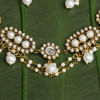Ethnic wear reimagined: Tanjena Mahbub's innovative vision for tribal textiles

These days, among the endless choices of Western wear, tribal fashion seems to have lost its appeal. But unlike others who mindlessly chase the latest trends, Tanjena Mahbub is an exception. An Associate Professor at the Shanto-Mariam University of Creative Technology in the Department of Fashion Design and Technology, Mahbub is determined to bring back the lost charm of ethnic wear.
Her mission? To weave these traditional threads into the fabric of modern fashion. "Right from the start, I have always wanted to work with handloom fabrics and continue my research studies in this field," Mahbub shares, reflecting on her early aspirations. She has passionately dug deep into the rich soil of Bangladesh's heritage, unearthing the traditional handloom techniques of indigenous communities.

This vision has been central to her teaching philosophy, encouraging the students at Shanto-Mariam University to delve into Bangladesh's handloom fabrics and work with the local artisans – eventually, representing the artisans and fabrics nationally and internationally. "As a Bangladeshi fashion designer, we want our students to know the heritage and traditions of this country first, and then, they can explore different textiles worldwide," she explains, emphasising the importance of grounding in one's cultural roots before branching out.

Mahbub's academic pursuit, particularly her master's thesis focused on traditional handloom fabrics, has led her to work closely with the Chakma community. Through her immersive experiences, she discovered the unique motifs that define each tribal group's identity, a realisation that spurred her to investigate, explore and know more about the specific traditions of the Chakma community.

"In the Chakma community, there are only female weavers," Mahbub notes, highlighting the gender-specific roles that intrigued her and shaped her research focus. Her dedication to exploring the fashion opportunities presented by ethnic handloom fabrics – which are beautifully crafted by the tribal women of the Chakma community – has not only been an academic exercise but also a personal journey of inspiration and motivation.
"I was genuinely awed by witnessing their resilience," Mahbub recalls from her frequent visits to Rangamati, where she interacted with these weavers. Despite the challenges they face, including minimal compensation and health issues like dry eyes from their meticulous work, their unwavering commitment to weaving has profoundly impacted Mahbub. Drawing inspiration from the traditional weaving techniques, vibrant colours, and climate-friendly fabrics of the Chakma attire, Mahbub has skilfully incorporated these elements into her designs.

Utilising unique Chakma motifs as the main theme, she has experimented with eco-friendly matka silk and innovative techniques such as patchwork and karchupi needlework, performed by craftswomen, to create a collection that not only embodies sustainability but also showcases the rich cultural heritage of Bangladesh.

"I aim to showcase the rich and diverse cultural heritage of Bangladesh through my designs," she asserts, highlighting her collection of fusion wear that caters to enthusiasts of traditional Bangladeshi clothing who wish to express their cultural pride through their attire.
Truly, in Tanjena Mahbub, we find not just an educator or a designer, but a visionary who embodies the true spirit of creativity and cultural exchange. Through her pioneering efforts, she not only honours the legacy of Bangladesh's indigenous communities but also paves the way for future generations to appreciate and preserve tribal fashion – simultaneously, inspiring us to look beyond the surface and appreciate the deeper stories woven into the clothes we wear.
Photo: Courtesy

 For all latest news, follow The Daily Star's Google News channel.
For all latest news, follow The Daily Star's Google News channel. 








Comments